Mastitis In Dogs
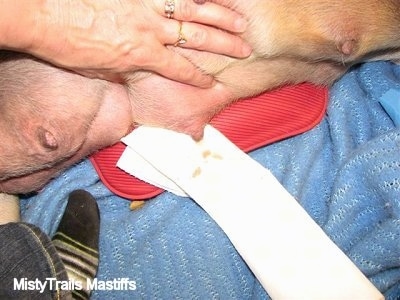
Mastitis is an infection of the milk ducts. Also called mammitis or mastadenitis, during nursing, it can be caused by a breast (teat) engorgement (swelling). Mastitis can also be caused by a blocked milk duct. You may see cracked or damaged skin or tissue around the nipple. Bacteria get inside, either by a crack or even through the pores, and can infect the dam suddenly, even if the teat is not engorged. An engorged breast is a mild form of mastitis. Mastitis, if not treated, can lead to gangrene mastitis. Gangrene mastitis is caused by bacteria that do not require oxygen in order to grow (anaerobic bacteria). The skin turns black and dies, leaving a huge hole that will drain pus-blood. The dam will have a high temperature and needs antibiotics. Gangrene mastitis results in the dam losing the teat. If your dam develops mastitis, begin treatment immediately to avoid it turning into gangrene mastitis.
Teat with mastitis, which can be common. This dam needs to go on antibiotics NOW. This is a medical emergency where TIME is of the essence. Mastitis is very aggressive and fast-moving, so the sooner antibiotics are started, the better chance of not having a blowout. A blowout is the swelling/infection that will try to come out the side of the breast, like a volcano that wants to erupt.
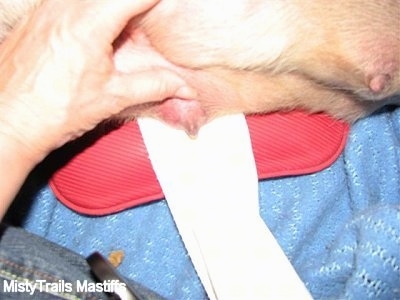
Notice how swollen the infected teat is. The breast is placed on a hot water bottle. Hot packs on the area are vital to the dam’s recovery.
Everybody wants to know “what drug is the best” for curing an infection, and yet the best thing possible for any infection is when the natural principles of the body are working optimally. (Why hot compresses are used to help fight off infection?) The extreme heat brings the blood to the site. A rush of blood coming to the site, thanks to a hot compress application, means more and more fresh blood cells (preferably white blood cells) are available to invigorate and fight off infection. Without the compresses, the blood is not able to get to the site as readily, which means the infection will essentially grow-and-grow unchallenged.
The dam is on antibiotics and I am adding probiotics (acidophilus capsules or yogurt) to the puppies’ food.
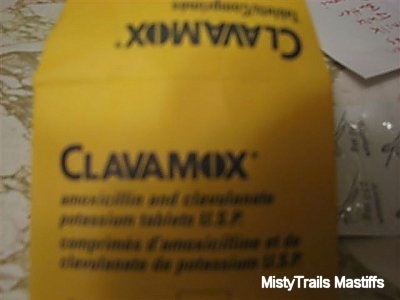
The antibiotic Clavamox is given to the dam to help fight the infection
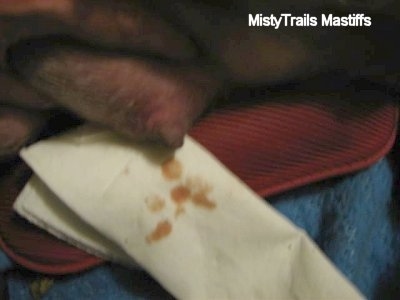
There is mixed advice on whether or not pups should nurse on the infected teat. Some say yes and some say no. The treatment for mastitis in humans consists of letting the baby nurse on the infected side as much as possible, rotating the baby in a different direction each feeding to clear all parts of the milk duct.
Some breeders are concerned it may cause diarrhea, however in this case, the pups were allowed to nurse and they showed no ill signs from it. Allowing them to nurse greatly helped in the dam's recovery process. Remember, the pus is usually sterile once the dam's antibiotics have had about 48 hours to work. Pus is just the body's reaction to the infection. For the first 48 hours (before the antibiotics kick in) you have to watch WHICH pup nurses and watch for diarrhea and/or tummy upset. After that the antibiotics make the pus sterile. If you decide to skip the first 48 hours while the antibiotics kick in, you may be putting the dam's health in jeopardy. Hand-expressing the teat is not as effective as allowing a few pups to nurse. I think I caught this in the nick of time; waiting 12 hours and starting on antibiotics in the morning could have made this much worse.
You CANNOT let the pups nurse if you cannot monitor which ones did, and closely monitor those particular puppies. It is also not recommended to only place ONE pup (the same pup each time) on the infected teat if it can be avoided, so the pups can take turns nursing and will not solely get their milk from that teat, putting the pups’ chin closest to the tender spot. Rotate a few pups (the same few each time) on that teat, keeping track of who nursed and when. In this case I have let four of the 11 puppies nurse on this boob and they did not show any signs of stomach upset. This greatly helped in my dam's recovery. You do not want your dam to develope gangrene mastitis... Which would be next if left untreated or not treated properly.
The bottom line is, it is best for the dam's health to allow the pups to nurse on the infected teat. HOWEVER, you have to know what you are doing. The situation has to be monitored. Many breeders do not know the difference in their puppies and they wouldn't know which puppy nursed or which one had diarrhea and they don't put the time into it to find out. So a sick pup could get sicker. Because of that, a lot of vets will advise that the average person not allow the pups to nurse from the infected teat, assuming they will not keep a close enough watch on the situation. If you are an attentive breeder that KNOWS and monitors her puppies you could let them nurse. If you work, and the pups are in the basement and tended to once a day, don't let them nurse from that teat. You will have to duct tape that teat over. Keep in mind, duct taping the teat and not allowing the pups to drain the teat is putting the dam's health at risk and on the other hand, allowing the pups to nurse on the infected teat and not properly monitoring is putting the pups at risk. The best solution to this is to be attentive to your puppies. Keep track of which selected pups nurse from that teat. Rotate them so the same pup does not nurse from that teat twice in a row. Watch the pups who are allowed to nurse on that teat poop to ensure they do not develop diarrhea. If done properly, there will be no ill effects on the pups and your dam will have a better chance of recovering.
A compress of hot clothes soaked in vinegar can help the infection come to a head, allowing it to be reabsorbed by the body, preventing it from bursting.
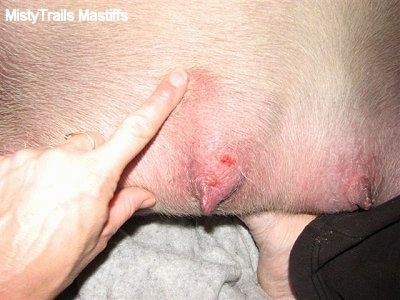
The infection is not in the nipple but way up high, mostly where my finger is pointing, in the milk gland. Infections accumulate about two to three inches from the actual nipple and sometimes it is in between two nipples.
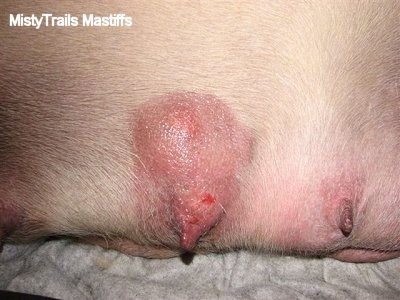
Just over 30 hours after onset, see the normal teat beside the infected one. At this time we are just praying the antibiotics were started in time, as the spot, up 2 inches, would be the blowout spot.
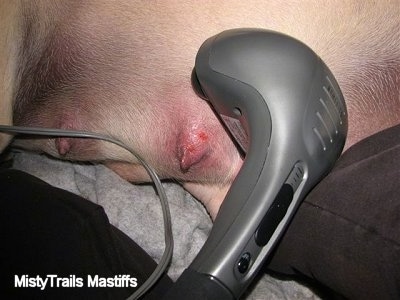
Massaging the breast to help loosen up the infection and allow the body to fight it more effectively. It is also good to continue draining the teat by hand to express out the infected milk and pus, not only for the pups’ sakes, but for the dam's sake. Mastitis will heal up quicker if you drain the breast as often as possible. When expressing, you need to get BEHIND the lump with your fingers and try to squeeze it out.
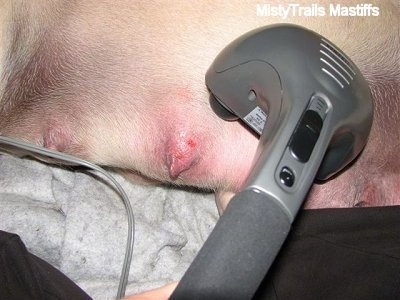
30 hours after onset
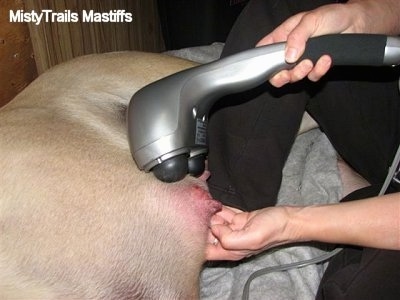
30 hours after onset
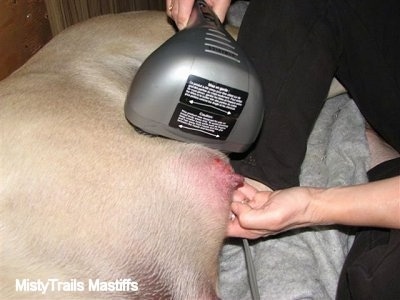
30 hours after onset
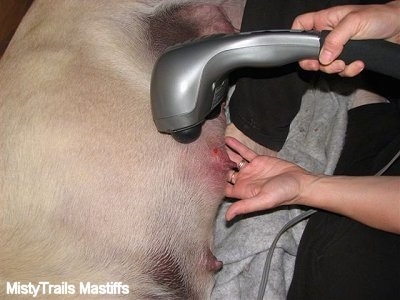
30 hours after onset
45 hours after onset—continue putting hot packs on the area. Hot-packing is the key to success. It helps the infection to come to a head without doing a lot of damage.
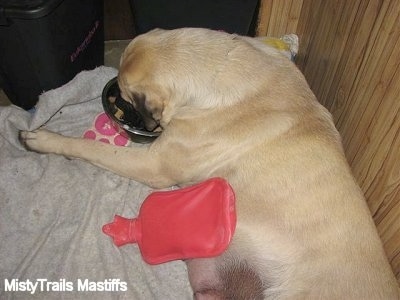
Sassy with her hot water bottle, which is being used as a heating pad for her mastitis treatment. You can also place the dam in a tub of warm water.
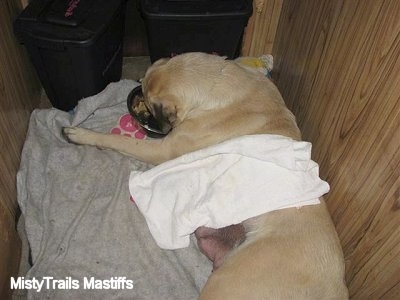
Placing a towel over the heat source helps hold the heat in.
Day 6 of mastitis
Things are clearing up.
Day 7 of mastitis, clearing up. The milk is coming out white, the swelling is down.
It is just scabs now.
Mastitis after two weeks—I BEAT IT... and the teat still works! All of the extra care put into getting Sassy better paid off!
OTHER REMIDES THAT CAN BE USED
Another remedy that can be used is cabbage leaves right from your grocery store. Cabbage leaves are known to have anti inflammatory properties. Use the leaves as a compress directly on the effected area and it can tremendously make a difference. BUT BE MINDFUL that using cabbage leaves will dry out the nipple and any other nipples you are placing the cabbage on. so puppies may no longer get milk from the nipple. But it may just be the the thing that in your case that saves the nipple.